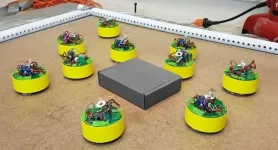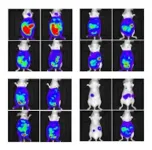(Press-News.org) Anyone with children knows that while controlling one child can be hard, controlling many at once can be nearly impossible. Getting swarms of robots to work collectively can be equally challenging, unless researchers carefully choreograph their interactions -- like planes in formation -- using increasingly sophisticated components and algorithms. But what can be reliably accomplished when the robots on hand are simple, inconsistent, and lack sophisticated programming for coordinated behavior?
A team of researchers led by Dana Randall, ADVANCE Professor of Computing and Daniel Goldman, Dunn Family Professor of Physics, both at Georgia Institute of Technology, sought to show that even the simplest of robots can still accomplish tasks well beyond the capabilities of one, or even a few, of them. The goal of accomplishing these tasks with what the team dubbed "dumb robots" (essentially mobile granular particles) exceeded their expectations, and the researchers report being able to remove all sensors, communication, memory and computation -- and instead accomplishing a set of tasks through leveraging the robots' physical characteristics, a trait that the team terms "task embodiment."
The team's BOBbots, or "behaving, organizing, buzzing bots" that were named for granular physics pioneer Bob Behringer, are "about as dumb as they get," explains Randall. "Their cylindrical chassis have vibrating brushes underneath and loose magnets on their periphery, causing them to spend more time at locations with more neighbors." The experimental platform was supplemented by precise computer simulations led by Georgia Tech physics student Shengkai Li, as a way to study aspects of the system inconvenient to study in the lab.
Despite the simplicity of the BOBbots, the researchers discovered that, as the robots move and bump into each other, "compact aggregates form that are capable of collectively clearing debris that is too heavy for one alone to move," according to Goldman. "While most people build increasingly complex and expensive robots to guarantee coordination, we wanted to see what complex tasks could be accomplished with very simple robots."
Their work, as reported April 23, 2021 in the journal Science Advances, was inspired by a theoretical model of particles moving around on a chessboard. A theoretical abstraction known as a self-organizing particle system was developed to rigorously study a mathematical model of the BOBbots. Using ideas from probability theory, statistical physics and stochastic algorithms, the researchers were able to prove that the theoretical model undergoes a phase change as the magnetic interactions increase -- abruptly changing from dispersed to aggregating in large, compact clusters, similar to phase changes we see in common everyday systems, like water and ice.
"The rigorous analysis not only showed us how to build the BOBbots, but also revealed an inherent robustness of our algorithm that allowed some of the robots to be faulty or unpredictable," notes Randall, who also serves as a professor of computer science and adjunct professor of mathematics at Georgia Tech.
INFORMATION:
The collaboration is based on experiments and simulations also designed by Bahnisikha Dutta, Ram Avinery and Enes Aydin from Georgia Tech, as well as on theoretical work by Andrea Richa and Joshua Daymude from Arizona State University, and Sarah Cannon from Claremont McKenna College, who is a recent Georgia Tech graduate.
This work is part of a Multidisciplinary University Research Initiative (MURI) funded by the Army Research Office (ARO) to study the foundations of emergent computation and collective intelligence.
Funding: This work was supported by the Department of Defense under MURI award no. W911NF-19-1-0233 and by NSF awards DMS-1803325 (S.C.); CCF-1422603, CCF-1637393, and CCF-1733680 (A.W.R.); CCF-1637031 and CCF-1733812 (D.R. and D.I.G.); and CCF-1526900 (D.R.).
The Georgia Institute of Technology, or Georgia Tech, is a top 10 public research university developing leaders who advance technology and improve the human condition. The Institute offers business, computing, design, engineering, liberal arts, and sciences degrees. Its nearly 40,000 students, representing 50 states and 149 countries, study at the main campus in Atlanta, at campuses in France and China, and through distance and online learning. As a leading technological university, Georgia Tech is an engine of economic development for Georgia, the Southeast, and the nation, conducting more than $1 billion in research annually for government, industry, and society.
Smoking is the leading cause of preventable death in America and causes about 30% of all cancer deaths. That's why researchers with the UC Davis Comprehensive Cancer Center wanted to study the impact of a California law passed in 2016 that raised the tobacco sales age from 18 to 21. Their new study published in Preventive Medicine examines smoking behavior after the state implemented one of the first tobacco 21 (T21) policies.
The study, conducted by UC Davis researchers Melanie Dove, Susan Stewart and Elisa Tong, looked at smoking patterns before and after the law passed and compared California and other states without a T21 policy. The data was from the 2012-2019 Behavioral Risk Factor Surveillance System.
"Most adult tobacco users start smoking ...
Batteries are a part of everyday modern life, powering everything from laptops, phones and robot vacuums to hearing aids, pacemakers and even electric cars. But these batteries potentially pose safety and environmental risks.
In a study recently published in Cell Reports Physical Science, researchers at Texas A&M University investigated the components of a different kind of battery -- a metal-free, water-based battery -- which would reduce the flammable nature of standard batteries and decrease the number of metal elements used in their production.
Most batteries are ...
Researchers led by Katsunori Tanaka and Kenward Vong at the RIKEN Cluster for Pioneering Research (CPR) in Japan have demonstrated that tumor growth can be reduced by therapy that tags cancer cells with different therapeutic molecules. In one case, the group was able to prevent tumors from forming in mice by targeting cancer cells with a compound that makes it difficult for the cells to clump together and form tumors. For tumors that already existed, they targeted cancer cells with toxic compounds that destroyed them. This study was published on April 23 in Science Advances.
One of the major problems with current cancer treatments is that their effects are not limited to cancerous cells in ...
An international team of researchers led by the University of Bergen has uncovered how organisms from crops to corals may avoid deadly DNA damage during evolution.
Our cells, and those of animals, plants and fungi, contain compartments that produce chemical fuel. These compartments contain their own DNA, which stores instructions for important cellular machinery. But this so-called oDNA (organelle DNA) can become mutated, corrupting the instructions and preventing cells making enough energy.
In humans and some other animals, a process called the "bottleneck" allows some offspring to inherit less mutated oDNA. This process needs mothers' egg cells to develop early, like in humans, where a human girl is born with all ...
DURHAM, N.C. - Fruits and veggies are good for you and if you are a lemur, they may even help mitigate the effects of habitat loss.
A new study sequencing the genome of four species of sifakas, a genus of lemurs found only in Madagascar's forests, reveals that these animals' taste for leaves runs all the way to their genes, which are also more diverse than expected for an endangered species.
Sifakas are folivores, meaning that the bulk of their diet is composed of leaves. Leaves can be difficult to digest and full of toxic compounds meant to prevent them from being eaten. Unlike our carefully selected spinach, tree leaves also don't taste great, and are not very nutritious.
Because of that, leaf-eaters ...
Strenuous efforts to prevent and treat malaria in recent decades have brought great benefits, particularly against disease caused by Plasmodium falciparum in countries in Africa and the Americas. But malaria caused by its "stealthier and more resilient cousin", P. vivax, now needs to be confronted with high priority, say Lorenz von Seidlein and Nicholas White of the Mahidol Oxford Tropical Medicine Research Unit in Bangkok, Thailand in a Perspective. The piece introduces a Collection on the prevention and treatment of P. vivax malaria in the open access journal PLOS Medicine, published ahead of World Malaria Day on April 25th.
In a Review article in the Collection, Sarah Auburn of the Menzies School of Health Research and Charles Darwin University, Darwin, Australia ...
Extremist perpetrators of violence often quote verses from their religion's holy scriptures that authorize, or even prescribe, attacks on enemies of the faith. Abdullah H., the Syrian now on trial who stabbed a homosexual couple with a knife and killed a man in Dresden in October 2020, also testified that he had been inspired to commit the crime by a Quranic sura. However, whether the religious motivation that extremist perpetrators of violence emphasize is causally related to their actions is often doubted. Now, WZB researchers Ruud Koopmans and Eylem Kanol can prove for the first time that verses in religious scriptures that legitimize violence can increase support for killing enemies of the faith.
Together with Dietlind Stolle, a German-Canadian ...
In a rare exchange, scientists and water resources engineers from Iran and Utah are collaborating on a bold scientific study to restore one of the world's largest saline lakes.
Lake Urmia -- a massive salt lake in Iran's northwest and a sister to Utah's Great Salt Lake -- has lost nearly 95 percent of its volume over the last two decades. As water levels drop, salinity spikes, threatening the lake's brine shrimp population and the flamingos and other bird species that depend on the shrimp for food. Lake levels are so low that at some coastal resorts, tourism boats must be pulled a kilometer (0.6 mile) or more from shore by tractor before reaching suitable depths. In addition, new land bridges are forming in the drying lake bed which allows mainland predators ...
Over the last 60 years, scientists have been able to observe how and when genetic information was replicated, determining the existence a "replication timing program", a process that controls when and in what order segments of DNA replicate. However, scientists still cannot explain why such a specific timing sequence exists. In a study published today in Science, Dr. David Gilbert and his team have answered this 60-year-old question.
"Why would cells care about the order in which they replicate DNA?" asked lead scientist Dr. Gilbert. "After all - all cells need to replicate all their DNA. Our hypothesis has been ...
A lobster's underbelly is lined with a thin, translucent membrane that is both stretchy and surprisingly tough. This marine under-armor, as MIT engineers reported in 2019, is made from the toughest known hydrogel in nature, which also happens to be highly flexible. This combination of strength and stretch helps shield a lobster as it scrabbles across the seafloor, while also allowing it to flex back and forth to swim.
Now a separate MIT team has fabricated a hydrogel-based material that mimics the structure of the lobster's underbelly. The researchers ran the material through a battery of stretch and impact tests, and showed ...






